Inventory Tax Groups and Advanced Sales Tax Features
Required for regions that have multiple sales tax rates based on a product group.
In this article
Getting Started | Configure Tax Groups | Merge Tax Groups | Features | Enhancements
Getting Started
Inventory Tax Group settings are important to calculating sales tax correctly within EBMS. The tax group setting is used to define product groups such as various services, clothing, groceries, prepared food, oil products, publications, and other products or services. This feature gives the user the ability to set different tax rates based on a product group.
The Advanced Sales Tax Module is an optional EBMS module. If you are interested in adding it to your subscription, contact your Koble Systems account manager.
The Inventory Tax Groups feature within the EBMS software is an advanced feature that is needed in the following situations:
-
Tax rates differ based on the product that is being sold. For example, groceries are taxed at 3% and other items are taxed at 6%.
-
A customer can be sales tax exempt for a specific group of products. For example, oil products may be exempt from sales tax for a specific group of customers. With the Inventory Tax Group feature, the user can configure the oil products group as exempt. The user must manually mark items as exempt if this feature is not installed.
-
The user is required to collect tax from multiple tax jurisdictions (states) and the products exempted from sales or use tax differ from state to state. For example: groceries are exempt in state A, but are taxable in state B, or clothing is exempt in state B, but not in state A.
-
TaxJar AutoFile subscription service is being used to file taxes. Review TaxJar AutoFile for more details on this subscription service.
-
The software ships with a few basic tax groups: Taxable, Non-Taxable, and not tax group. Additional tax groups must be created within EBMS to match the tax requirements of the state(s) with nexus. Contact your accountant or review the nexus definition if you need assistance to determine which states need to be considered for sales tax nexus. The ability to configure tax groups in EBMS or to use the TaxJar AutoFile service requires the Advanced Sales Tax module. Review Optional EBMS Modules if the Advanced Sales Tax module must be added.
Configure Tax Groups
Complete the following steps to configure Inventory Tax Groups:
- Select Sales > Sales Tax > Rates and click on the Inventory Tax Groups tab as show below:
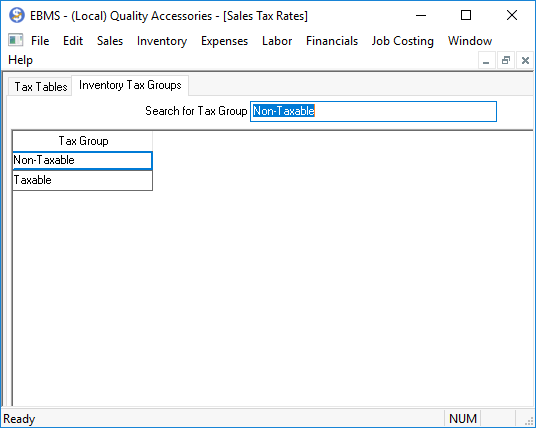
-
The Inventory Tax Groups shown above are the standard groups shipped with EBMS. These groups can only be changed if the Advanced Sales Tax module has been installed. Review Optional Modules if the Advanced Sales Tax module must be added.
-
It is very important that all the tax rate methods are set up before continuing with tax groups:
-
Attach the TaxJar SmartCalc tool to determine sales tax rates: Review Configuring EBMS to use TaxJar Tax Rates for setup instructions.
-
Enter tax rates into EBMS: Review Establishing Tax Rates for more details on creating rates within EBMS.
-
Click on the Non-Taxable Tax Group (if it exists) to replace this group with multiple exempt or reduced tax rate groups.
-
Click the New button on Sales > Sales Tax > Rates > Inventory Tax Groups tab to launch the New Sales Tax Group wizard as shown below.
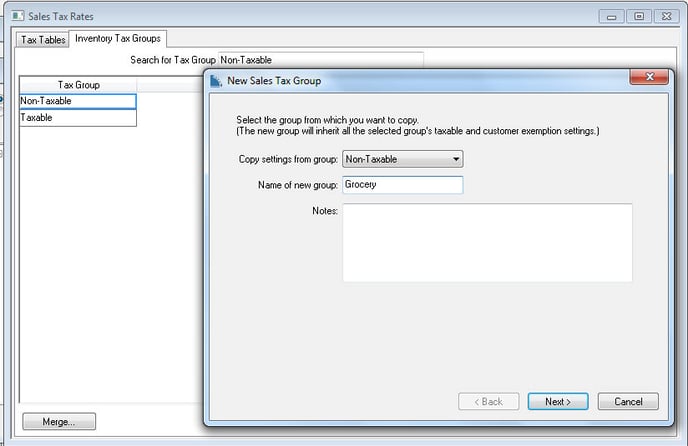
-
Select the Non-Taxable option from the Copy settings from group drop down options as shown above.
-
Enter the Name of new group label. Use the TaxJar category label for the new inventory tax group label even if TaxJar is not being used. Review this TaxJar API reference for a current category list. Add only the tax groups that apply to the products sold at the company. Consider all the company's state sales tax nexus. For example:
Other Taxable: The group that is used for standard taxable product groups
Prepared Foods and Sodas group would not be required to be separate inventory tax groups since the rates are the same for all 4 tax jurisdictions.
Groceries requires a separate group since rates are lower or groceries are exempt.
Clothing requires a sperate group because of the PA exemption. -
Enter the Name of new group and click on the Next button to continue to the following dialog:
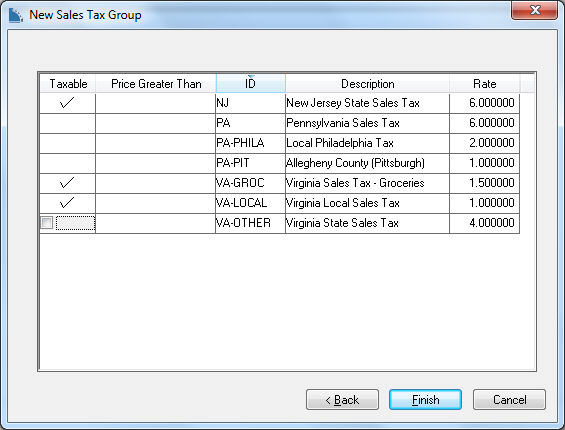
-
Enable the Taxable option for all items that are taxable for the new tax group. Disable the Taxable option for all taxes that exempt the items within the new Inventory Tax Group. This step can be ignored if the TaxJar SmartCalc service is being used to calculate sales tax rates. Click Finish to create new group.
-
Relabel or make the Non-Taxable group inactive since it was divided to clarify the original inventory group by double-clicking on the original Inventory Tax Group, clicking on the General tab, and changing the Tax Group label.

Inventory groups should be clearly labeled to avoid confusion when identifying the tax group within the inventory system. -
Open the new Inventory Tax Group from the Tax Group list by double-clicking on the Grocery record.
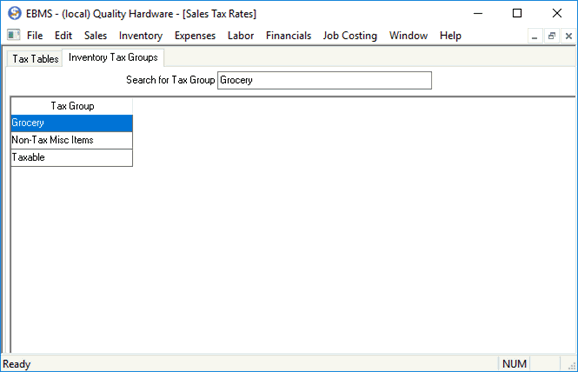
-
Click on the Taxability tab to set up EBMS taxable rates. This step can be ignored if the TaxJar SmartCalc service is being used to calculate sales tax rates.

-
Select the proper taxable switch from the following three options:
-
Select This group is taxable for all the taxes in the selected folder option to make the current Inventory Tax Group taxable for all tax rates/jurisdictions. Set the minimum unit price if sales tax is not applicable until the unit price of the item is greater than the If the unit price is greater than value.
-
Select The group is not taxable for any of the taxes in the selected folder option to make the current group non-taxable.
-
Select This group’s taxable settings vary for taxes in the selected folder option to set the taxable setting within each rate/jurisdiction. This option is used if the current Inventory Tax Group (Grocery) varies between states or jurisdictions. In the example above, Groceries are marked as taxable in New Jersey, but not in Pennsylvania jurisdictions. Set the minimum unit price if sales tax is not applicable until the unit price of the item is greater than the Price Greater Than value.
-
Click on the TaxJar tab to associate the appropriate TaxJar category if the TaxJar cloud-based sales tax service subscription is enabled. Enter the corresponding TaxJar Category number as listed in this TaxJar API reference. Review Configuring EBMS to use TaxJar Tax Rates for more configuration requirements to use TaxJar to calculate taxes. This step can be ignored if EBMS is used to calculate sales taxes.
-
Click on the Inventory Item tab to view the items that are within the current Inventory Tax Group. Items cannot be added within this tab. A product’s Tax Group must be set within the inventory item’s General tab. Review the Changing Product Information section of the Inventory documentation for more details on changing product information including the tax group.
-
Click OK to return to the Inventory Tax Groups.
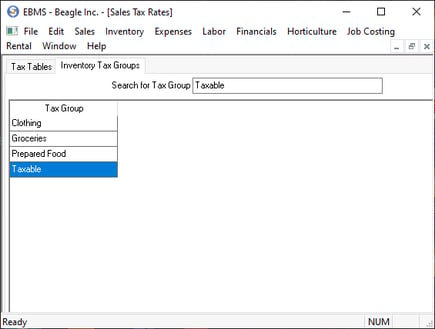
-
Repeat the steps above for each new Inventory Tax Group.
Merge Tax Groups
Use the Merge button to combine two existing groups.
The products within the inventory catalog should be moved into the appropriate Inventory Tax Group. Open the General tab on a product record to change the Tax Group setting as shown below:

Review the Edit Defaults, Filter Down Data, and Globally Change Data section of the main documentation for more details on changing the Tax Group for an entire group of items.
Features
- User-defined sales tax groups used to group inventory items based on the sales tax requirements. This option gives the user maximum flexibility to calculate different sales tax rates or exempt sales tax based on a group of items.
- Facilitates multiple sales tax rates for a group of inventory items.
- Allows the user to have multiple sales tax exemptions for a single customer based on a sales tax group.
- Gives the user the ability to configure the rates and exemptions for multiple sales taxes that apply to a common jurisdiction. For example, some Canadian provinces require both a GST and a PST sales tax for their province. Some USA sales taxes require a state and local tax for the same jurisdiction.
- Manage and calculate more advanced taxes such as VAT or Luxury taxes.